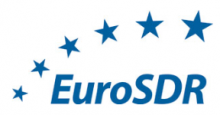Digital Twins for National Mapping and Cadastral Agencies and other governmental organisations
In January 2022, EuroSDR organised a workshop addressing the impact of the Digital Twin concept for NMCAs. The workshop was held online and divided over two mornings: Friday 21st and 28th of January 9:30 – 12:30 (CET).
Programme of the workshop: Click here (or read more below).
Recordings: You can watch the recordings of the presentations here.
Background
The concept of a Digital Twin (DT) originates from industry and manufacturing. In the geospatial domain, the concept has been gaining significant momentum since it was introduced in 2012. Despite the frequent use of the term, there is not a common definition in use and, consequently, the term is used in different ways: as a digital replica of an asset in a BIM context, as a 3D city or landscape model, as a digital representation of the physical environment including its dynamic processes, as geospatial information infrastructure, etc.
Even though a single definition of a DT in the geospatial domain is lacking, there is consensus that it should be based on 3D city models, containing objects with geometric and semantic information; it should contain real-time sensor data; and, it should integrate a variety of analyses and simulations to be able to make the best design, planning and intervention decisions.
Digital Twin and National Mapping and Cadastral Agencies
The introduction of the concept Digital Twin in the geospatial domain offers a lot of potentials as it offers a comprehensive shared vision of the value of geo-information in solving societal issues. The geospatial domain has provided solutions that are nowadays assigned to the DT concept, long before the term DT was introduced. Consequently, geospatial organisations, like NMCAs and other governmental organisations, are well-equipped to address DT-challenges as how to spatially represent the current state of reality as accurately and up-to-date as possible; how to integrate geo-data from highly heterogeneous and dynamic sources and develop standards for this; and how to develop a geospatial data infrastructure to serve more than one purpose; how to generate visual rendering to stimulate serendipitous knowledge building etc.
Aim of the workshop
The aim of our workshop was to exchange experiences and plans from NMCAs and other governmental organisations on Digital Twin-related activities, to discuss the impact of the Digital Twin concept for them and to identify remaining issues, challenges as well as opportunities. It was not the aim to come to a shared definition on the concept Digital Twin but rather to discuss the meaning of the concept for governmental organisations: What are the ongoing DT-activities, what are the use cases, lessons learned, uncertainties, opportunities etc.
Programme of the workshop
First day 21st of January | 9:30 – 12:30 (CET)
9:30 Opening and welcome
9:45 - 10:45 National Digital Twin Programmes
● UK: National Digital Twin programme overview, Mark Enzer, Head of the National Digital Twin programme (pdf), Miranda Sharp, Flex technical author, Director at Metis Digital (pdf)
● Smart Built Environment programme; Digital Twins in the Built Environment: Pre-study of Swedish Ongoing Activities and Future Recommendations, Andreas Ask, E&A Development AB, Sweden (pdf)
● NL: National Digital Twin of the physical environment, Jan Bruijn, Geonovum (pdf)
10:45 - 11:15 Break
11:15 - 12:15 Digital Twin Activities by NMCAs
Presentations by NMCAs about their ongoing activities addressing the following questions:
1) What does the concept of Digital Twin mean for NMCAs?; What is the state-of-the-art?
2) What are your related activities?; What is your role in creating and maintaining DTs?; What activities are you exploiting to implement Digital Twins?
3) What further DT challenges and opportunities do you see for your organisation?
● Swisstopo, A decade of the 3D digital landscape model in Switzerland, André Streilein (pdf)
● Kadaster, Digital Twin narrative at Kadaster, Marcel Reuvers (pdf)
● OS GB, Digital Twins of national infrastructure, Carsten Rönsdorf (pdf)
● BKG Germany, Plans to become a “smart country”, Federal Agency for Cartography and Geodesy (BKG), implementation of a digital replica of Germany, Patrick Knoefel (pdf)
12:30 Closure
Second day 28th of January | 9:30 – 12:45 (CET)
9:30 Welcome
9:45 Research on Digital Twins
● DAFNI – Data and Analytics Facility for National Infrastructure, Liz Varga, UCL (pdf)
● Digital Twin Cities Centre Sweden, Anders Logg (pdf)
● IGN: Creating Digital Twins of Cities: From Data Acquisition to 3D Modelling, Bruno Vallet, IGN (pdf)
10:45 Break
11:15 Digital Twin activities outside Europe
● Digital Twin related activities at the Urban Analytics Lab, Filip Biljecki, National University of Singapore (pdf)
● Project PLATEAU: The initiatives of Japanese Digital Twin, Uchiyama Yuya, MLIT (Ministry of Land, Infrastructure, Transport and Tourism), and Ishimaru Nobuhiro (Open Geospatial Consortium CityGML Standards WG), Japan (pdf)
12:00 Intermediate results of questionnaire & Interactive session (pdf)
12:45 Closure
Organising commitee
The following persons were involved in the preparation of this workshop:
Claire Ellul, UCL
Bénédicte Bucher, IGN France
Julià Talaya, ICGC, Barcelona
Lars Harrie, University of Lund
André Streilein, Swisstopo
Magdalena Grus, Kadaster
Xanthe Duivenbode, Kadaster
Martijn Rijsdijk, Kadaster
Jantien Stoter, Kadaster & TU Delft

